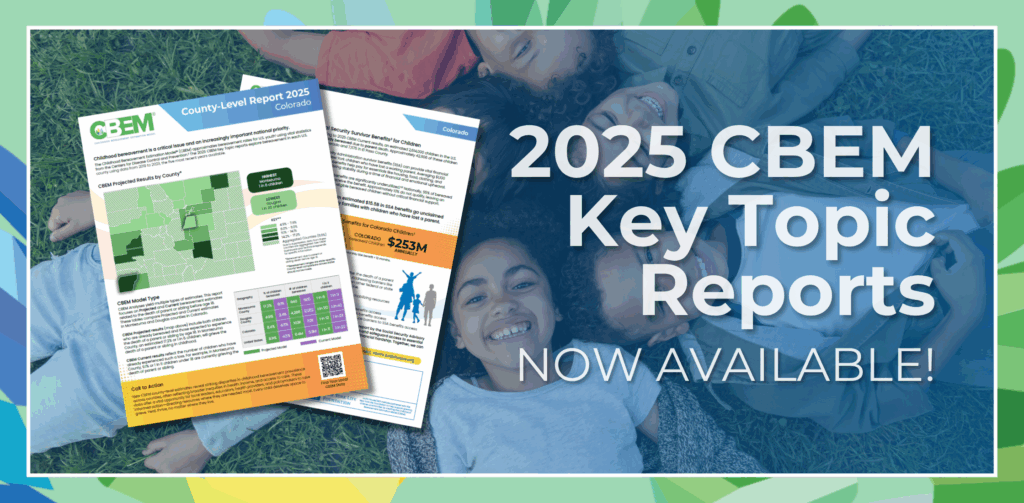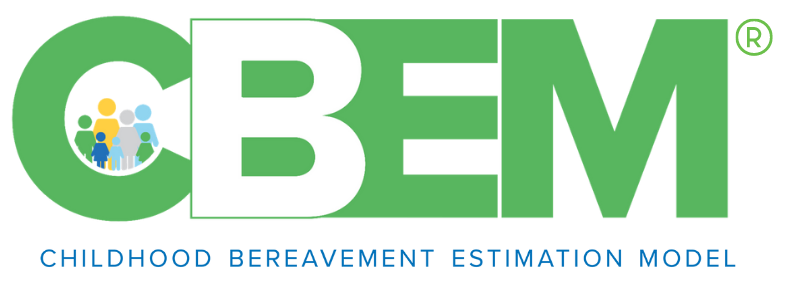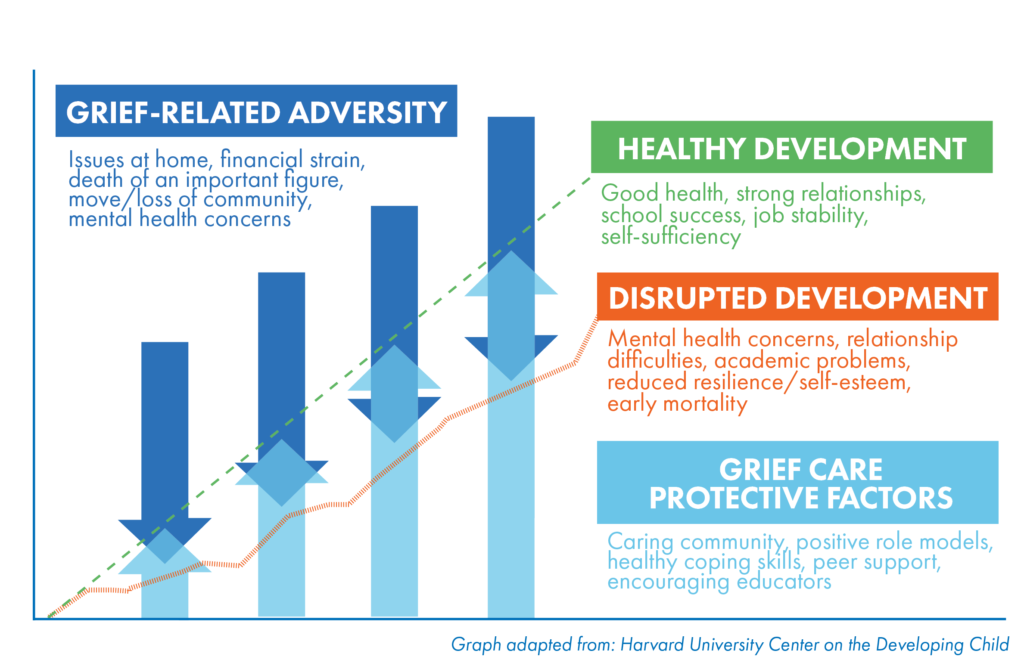Childhood Bereavement Estimation Model (CBEM)
About Childhood Bereavement | CBEM Dashboard | Additional Resources

2025 CBEM Key Topic County-Level Reports Now Available
In partnership with the New York Life Foundation, Judi’s House / JAG Institute is proud to release the 2025 Childhood Bereavement Estimation Model (CBEM) County-Level Reports, offering the most comprehensive look yet at childhood bereavement across the United States.
These updated reports provide detailed insights for all 50 states and every U.S. county, revealing how geography and local factors shape children’s experiences of grief and loss. Explore the data to see how your state and county compare by visiting the CBEM Dashboard and downloading the reports today.
Special Feature: Social Security Survivor Benefits
This year’s release includes a special focus on Social Security Administration (SSA) survivor benefits, highlighting a critical gap in support for grieving families. Each year, an estimated $15.5 billion in survivor benefits goes unclaimed by children and families who may qualify after the death of a working parent.
To help close this gap, Judi’s House / JAG Institute supports the following recommendations to strengthen access and awareness:
- Bereaved families: Call SSA at 1-800-772-1213 as soon as possible to initiate benefits access
- Grief centers and schools: Identify eligible children and families to facilitate SSA benefits access
- Advocates & policymakers: Work together to advance policy changes and reduce barriers to SSA benefits access
Together, these actions can help ensure that every child and family receives the support they deserve during one of life’s most difficult times.
Childhood Bereavement: A Critical Issue

An estimated 6.4 million children in the United States will experience the death of a parent or sibling by age 18.
Childhood grief has profound impacts on youth, families, and communities. In partnership with the New York Life Foundation, we developed the Childhood Bereavement Estimation Model (CBEM) to understand the magnitude of the issue. The CBEM approximates rates of U.S. children and youth who will experience the death of a parent or sibling by the time they reach adulthood.
This information helps communities evaluate the impacts of unaddressed grief, campaign for grief resources, and ultimately, contribute to improved outcomes for grieving families everywhere.
CBEM Dashboard
Discover the CBEM Dashboard – your centralized hub for dynamic bereavement data, customized visualizations, and integrated tools. Gain insights, support advocacy, and take action to better serve bereaved children and families.
Childhood Bereavement in the United States
2025 CBEM State results vary greatly across the nation. New Mexico has the highest concentration of bereaved children with 14.2% projected to experience the loss of a parent or sibling by age 18. In comparison, Utah has the lowest concentration with 6.8%. National, state, and county-level findings help advocates better understand and support the unique needs of bereaved children in their communities.
How many children and youth will be bereaved in YOUR state? Hover over the map to view CBEM rankings and rates.
Bereavement due to parent or sibling death by age 18.

Childhood Bereavement: The Cost of Inaction
Research shows that bereaved children are at an increased risk of disrupted development. Unaddressed childhood grief and trauma can lead to short- and long-term difficulties including decreased academic performance, mental health issues, and early mortality.

Timely support introduced at critical junctions aids in healthy development. Each day, bereaved youth turn to peers and adults for assistance in managing complex grief reactions. Data from the CBEM reinforces the need for access to grief-focused education and programming that helps communities respond compassionately and confidently.
CBEM Key Topics
Cause of Death
Released in 2022, the Leading Causes of Death Report focuses on the five leading causes of death for youth and adults, respectively, and provides the percentage and number of children bereaved by each cause. Examining childhood bereavement through this lens offers opportunities for collaboration and advocacy among groups focused on these causes. The information encourages discussion and considerations about how to tailor care to the unique needs of each child and family.
County-Level
2025 County-Level CBEM data is now available!
The 2025 County-Level Key Topic Report represents an important advancement in our mission to understand and address childhood grief. This report estimates children bereaved due to parent and sibling death for each county in the U.S.
This year’s Key Topic Report features a special focus on Social Security survivor benefits, highlighting that an estimated $15.5 billion in support goes unclaimed each year by children and families who have lost a working parent, along with recommendations to improve access and awareness.
More discrete CBEM results empower childhood bereavement champions to advocate for tailored interventions and resources to build systems of care that are grounded in the realities of their specific populations.
Household Income
When it comes to childhood bereavement, income matters.
The 2024 Household Income Key Topic Report focuses on the intersection of childhood bereavement and household income. Providing state-by-state insight, these analyses reveal differences in bereavement rates based on county median incomes. In 44 out of 50 states, children living in the lowest income group counties are more likely to be bereaved than those living in the highest income group. In the six outlier states, low income is still associated with increased childhood bereavement.
Ready access to essential resources such as stable housing, safe communities, quality education, physical and mental healthcare, clean water, and healthy food play an important role in mitigating negative outcomes associated with childhood bereavement. Restricted income is associated with poor health outcomes and increased exposure to negative environmental conditions that reduce life expectancy.
Pandemic Impact
Released in 2022 and 2023, the National Pandemic Impact Report explores bereavement connected to parent’s death due to accidental drug overdose, COVID-19, suicide, and homicide by gunshot. The 2023 report includes additional point-in-time prevalence.
Children who have experienced a stigmatized death loss like those highlighted in these reports may experience feelings of isolation, guilt, and uncertainty. Findings in these reports reflect increases in childhood bereavement due to these stigmatized losses year over year.
Access the Reports | Watch the Videos | Access the Toolkit | Action Plan
Race & Ethnicity
The 2021 Key Topic Report addresses race and ethnicity at the state and national levels. The reports reveal sharp differences in bereavement prevalence and underscore the need for critical and timely grief supports for children. Additionally, each report highlights the leading causes of death in each population. Taken together, these data points illuminate geographic discrepancies, creating opportunities for focused campaigns and efforts to narrow the gaps.
These results complement CBEM Standard reports. Using data from CDC WONDER, results are presented for each racial (American Indian or Alaska Native, Asian or Pacific Islander, Black or African American, White) and ethnic (Hispanic or Latino) category.
Additional Resources
Join us in elevating childhood bereavement to a critical public priority. You can keep kids on track to health and healing by utilizing our CBEM resources to educate your community and increase awareness.
Judi’s House/JAG Institute partnered with the New York Life Foundation to help support grieving children and families by creating the Childhood Bereavement Estimation Model.

